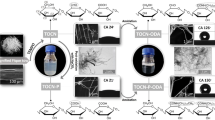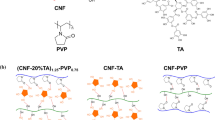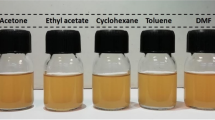Abstract
Amidation and ionic complexation were evaluated as surface modification treatments for TEMPO-oxidized nanocelluloses (TONc), using octadecylamine (ODA) as the modifying compound. Effects of the two treatments on TONc with respect to degree of ODA substitution, surface hydrophobicity, crystalline characteristics, and thermal decomposition properties were investigated, respectively, with elemental analysis, contact angle measurements, X-ray diffraction spectroscopy, and thermogravimetric analysis. Both treatments resulted in complete substitution of TONc surface carboxyl groups with ODA, transforming TONc surfaces from hydrophilic to hydrophobic. A slightly greater than one-to-one ODA-to-carboxyl ratio was found for the ionic complexation product, giving it a more hydrophobic character than the amidation product. Furthermore, the ionic complexation product was found to be surprisingly stable in acidic environment and was able to resist dissociation at fairly low pH. TONc from both treatments could be readily dispersed in organic solvents of wide-ranging polarities, making ionic complexation an equally effective surface modification approach as amidation for the hydrophobization of TONc surfaces. It was also found, through X-ray diffraction results that the crystalline structure of TONc was preserved even after the surface modification treatments. Finally, the thermal stability of TONc was slightly increased as a result of the surface modification treatments as evidenced by slight shifts to higher values of TONc thermal decomposition temperature.









Similar content being viewed by others
Notes
Reported for the combustion of cationically-modified microcrystalline cellulose and corn starch in air atmosphere (Aggarwal and Dollimore 1997).
References
Aggarwal P, Dollimore D (1997) The combustion of starch, cellulose and cationically modified products of these compounds investigated using thermal analysis. Thermochim Acta 291:65–72
Araki J, Wada M, Kuga S (2001) Steric stabilization of a cellulose microcrystal suspension by poly(ethylene glycol) grafting. Langmuir 17:21–27
Azzam F, Heux L, Putaux JL, Jean B (2010) Preparation by grafting onto, characterization, and properties of thermally responsive polymer-decorated cellulose nanocrystals. Biomacromolecules 11:3652–3659
Bulpitt P, Aeschlimann D (1999) New strategy for chemical modification of hyaluronic acid: preparation of functionalized derivatives and their use in the formation of novel biocompatible hydrogels. J Biomed Mater Res 47:152–169
Clothup NB, Daly LH, Wiberley SE (1990) Introduction to infrared and Raman spectroscopy. Academic Press Inc, San Diego
Follain N, Montanari S, Jeacomine I, Gambarelli S, Vignon MR (2008) Coupling of amines with polyglucuronic acid: evidence for amide bond formation. Carbohydr Polym 74:333–343
Follain N, Marais MF, Montanari S, Vignon MR (2010) Coupling onto surface carboxylated cellulose nanocrystals. Polymer 51:5332–5344
Fukuzumi H, Saito T, Wata T, Kumamoto Y, Isogai A (2009) Transparent and high gas barrier films of cellulose nanofibers prepared by TEMPO-mediated oxidation. Biomacromolecules 10:162–165
Fukuzumi H, Saito T, Okita Y, Isogai A (2010) Thermal stabilization of TEMPO-oxidized cellulose. Polym Degrad Stab 95:1502–1508
Gousse C, Chanzy H, Excoffier G, Soubeyrand L, Fleury E (2002) Stable suspensions of partially silylated cellulose whiskers dispersed in organic solvents. Polymer 43:2645–2651
Habibi Y, Chanzy H, Vignon MR (2006) TEMPO-mediated surface oxidation of cellulose whiskers. Cellulose 13:679–687
Habibi Y, Goffin AL, Schiltz N, Duquesne E, Dubois P, Dufresne A (2008) Bionanocomposites based on poly(epsilon-caprolactone)-grafted cellulose nanocrystals by ring-opening polymerization. J Mater Chem 18:5002–5010
Heux L, Chauve G, Bonini C (2000) Nonflocculating and chiral-nematic self-ordering of cellulose microcrystals suspensions in nonpolar solvents. Langmuir 16:8210–8212
Isogai A, Kado H, Goi Y (2010a) Cosmetics compositions containing oxidized cellulose fibers and functional components. Daiichi Kogyo Seiyaku Co., Ltd., Japan. Application: JP, 19 pp
Isogai A, Kado H, Goi Y (2010b) Gel compositions containing oxidized cellulose fibers with good resistance to salts and ionic surfactants. Daiichi Kogyo Seiyaku Co., Ltd., Japan. Application: JP, 43 pp
Isogai A, Kado H, Goi Y (2010c) Spray compositions containing oxidized cellulose fibers as thickeners, and sprayers therefor. Daiichi Kogyo Seiyaku Co., Ltd., Japan. Application: JP, 25 pp
Isogai A, Okita Y, Fujisawa S, Saito T (2011) TEMPO-oxidized cellulose nanofibrils dispersed in organic solvents. Biomacromolecules 12:518–522
Johnson RK, Zink-Sharp A, Renneckar SH, Glasser WG (2009) A new bio-based nanocomposite: fibrillated TEMPO-oxidized celluloses in hydroxypropyl cellulose matrix. Cellulose 16:227–238
Kato T, Isogai A, Saito T, Oaki Y, Nishimura T (2010) Composite material, functional material, process for producing composite material, and process for producing composite-material thin film. Chemical Indexing Equivalent to 152:264550 (WO) pp. Tokyo University, Japan. Application: JP, 38 pp
Katz S, Beatson RP, Scallan AM (1984) The determination of strong and weak acidic groups in sulfite pulps. Svensk Papperstidning 87:R48–R53
Lasseuguette E (2008) Grafting onto microfibrils of native cellulose. Cellulose 15:571–580
Li Z, Renneckar S, Barone JR (2010) Nanocomposites prepared by in situ enzymatic polymerization of phenol with TEMPO-oxidized nanocellulose. Cellulose 17:57–68
Mukai K, Kumamoto Y, Isogai A, Meiwa Z, Maezawa T, Ugajin T (2010) Gas-barrier material, gas-barrier molded article, and method for producing the gas-barrier molded article. Kao Corporation, Japan. Application: WO, 108 pp
Okita Y, Saito T, Isogai A (2009) TEMPO-mediated oxidation of softwood thermomechanical pulp. Holzforschung 63:529–535
Okita Y, Saito T, Isogai A (2010) Entire surface oxidation of various cellulose microfibrils by TEMPO-mediated oxidation. Biomacromolecules 11:1696–1700
Perez DD, Montanari S, Vignon MR (2003) TEMPO-mediated oxidation of cellulose III. Biomacromolecules 4:1417–1425
Petersson L, Mathew AP, Oksman K (2009) Dispersion and properties of cellulose nanowhiskers and layered silicates in cellulose acetate butyrate nanocomposites. J Appl Polym Sci 112:2001–2009
Saito T, Isogai A (2004) TEMPO-mediated oxidation of native cellulose. The effect of oxidation conditions on chemical and crystal structures of the water-insoluble fractions. Biomacromolecules 5:1983–1989
Saito T, Isogai A (2005) Ion-exchange behavior of carboxylate groups in fibrous cellulose oxidized by the TEMPO-mediated system. Carbohydr Polym 61:183–190
Saito T, Shibata I, Isogai A, Suguri N, Sumikawa N (2005) Distribution of carboxylate groups introduced into cotton linters by the TEMPO-mediated oxidation. Carbohydr Polym 61:414–419
Saito T, Nishiyama Y, Putaux JL, Vignon M, Isogai A (2006a) Homogeneous suspensions of individualized microfibrils from TEMPO-catalyzed oxidation of native cellulose. Biomacromolecules 7:1687–1691
Saito T, Okita Y, Nge TT, Sugiyama J, Isogai A (2006b) TEMPO-mediated oxidation of native cellulose: microscopic analysis of fibrous fractions in the oxidized products. Carbohydr Polym 65:435–440
Saito T, Kimura S, Nishiyama Y, Isogai A (2007) Cellulose nanofibers prepared by TEMPO-mediated oxidation of native cellulose. Biomacromolecules 8:2485–2491
Saito T, Hirota M, Tamura N, Kimura S, Fukuzumi H, Heux L, Isogai A (2009) Individualization of nano-sized plant cellulose fibrils by direct surface carboxylation using TEMPO catalyst under neutral conditions. Biomacromolecules 10:1992–1996
Salin IM, Seferis JC (1993) Kinetic-analysis of high-resolution TGA variable heating rate data. J Appl Polym Sci 47:847–856
Socrates G (2001) Infrared and Raman characteristic group frequencies. Wiley, Chichester
Suzuki A, Miyawaki S, Katsukawa S, Abe H, Iijima Y, Isogai A (2009) Cellulose nanofiber-containing base paper for processing paper. Nippon Paper Industries Co., Ltd., Japan. Application: JP, 10 pp
Vaca-Garcia C, Borredon ME, Gaseta A (2001) Determination of the degree of substitution (DS) of mixed cellulose esters by elemental analysis. Cellulose 8:225–231
van den Berg O, Capadona JR, Weder C (2007) Preparation of homogeneous dispersions of tunicate cellulose whiskers in organic solvents. Biomacromolecules 8:1353–1357
Williams DH, Fleming I (1980) Spectroscopic methods in organic Chemistr. McGraw-Hill Book Company (UK) Ltd., London
Yuan HH, Nishiyama Y, Wada M, Kuga S (2006) Surface acylation of cellulose whiskers by drying aqueous emulsion. Biomacromolecules 7:696–700
Zhou Q, Brumer H, Teeri TT (2009) Self-organization of cellulose nanocrystals adsorbed with xyloglucan oligosaccharide-poly(ethylene glycol)-polystyrene triblock copolymer. Macromolecules 42:5430–5432
Zhu LH, Kumar V, Banker GS (2001) Examination of oxidized cellulose as a macromolecular prodrug carrier: preparation and characterization of an oxidized cellulose-phenylpropanolamine conjugate. Int J Pharm 223:35–47
Acknowledgments
This study was carried out with the financial support of the Sustainable Engineered Materials Institute (SEMI), Virginia Tech College of Natural Resources and Environment in Blacksburg, Virginia.
Author information
Authors and Affiliations
Corresponding author
Electronic supplementary material
Below is the link to the electronic supplementary material.
Rights and permissions
About this article
Cite this article
Johnson, R.K., Zink-Sharp, A. & Glasser, W.G. Preparation and characterization of hydrophobic derivatives of TEMPO-oxidized nanocelluloses. Cellulose 18, 1599–1609 (2011). https://doi.org/10.1007/s10570-011-9579-y
Received:
Accepted:
Published:
Issue Date:
DOI: https://doi.org/10.1007/s10570-011-9579-y




